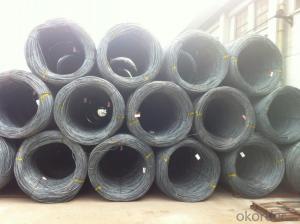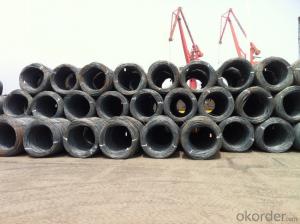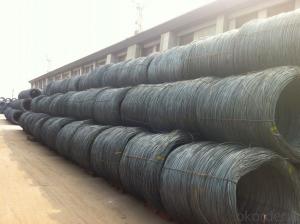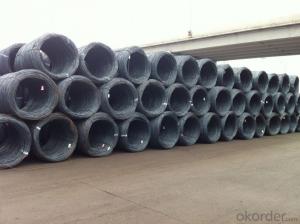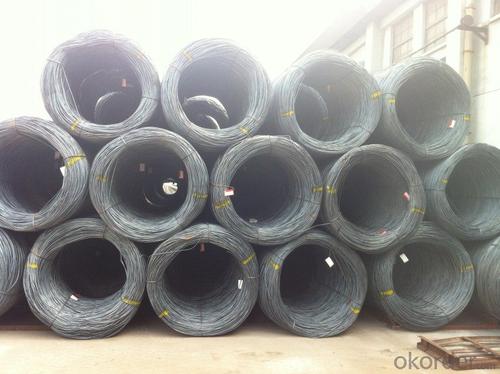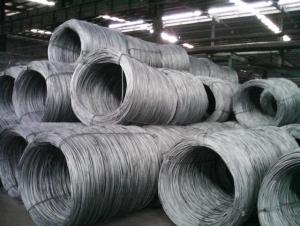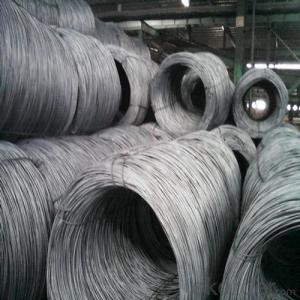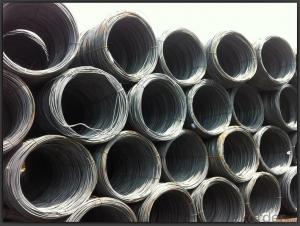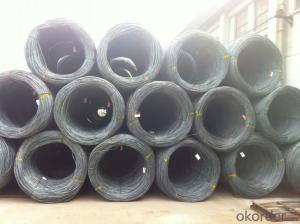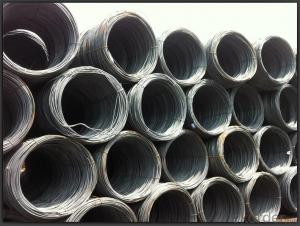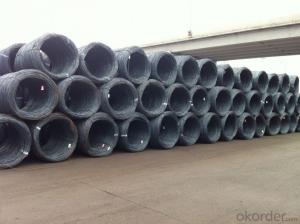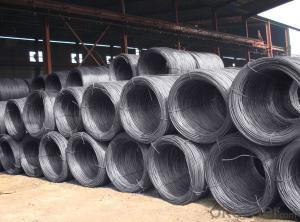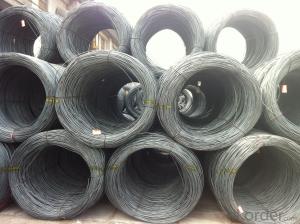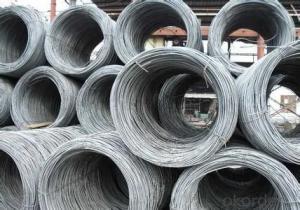Hot Rolled Wire Rods with Good Price SAE 1008
- Loading Port:
- Tianjin
- Payment Terms:
- TT OR LC
- Min Order Qty:
- 25 m.t.
- Supply Capability:
- 10000 m.t./month
OKorder Service Pledge
OKorder Financial Service
You Might Also Like
Product Description:
OKorder is offering Carbon Steel Wire Rod at great prices with worldwide shipping. Our supplier is a world-class manufacturer of steel, with our products utilized the world over. OKorder annually supplies products to European, North American and Asian markets. We provide quotations within 24 hours of receiving an inquiry and guarantee competitive prices.
Product Applications:
Carbon Steel Wire Rod are ideal for structural applications and are widely used in the construction of buildings and bridges, and the manufacturing, petrochemical, and transportation industries.After hot-rolled the products shaped into coil and delivery as finished product, including round, square, rectangular, hexagonal and so on. Since most of the products are round, it is generally called wire rod. Carbon steel wire rod is widely used in construction and manufacturing. Carbon steel wire rod is mainly used for reinforcement of reinforced concrete and welded structure or reprocessed (roberts , nail, etc.) materials, especially used to produce wire drawing, welding electrode, nails, spring, electronic, precise machinery parts and so on.
Product Advantages:
OKorder's Carbon Steel Wire Rod are durable, strong, and resist corrosion.
Main Product Features:
· Premium quality
· Prompt delivery & seaworthy packing (30 days after receiving deposit)
· Corrosion resistance
· Can be recycled and reused
· Mill test certification
· Professional Service
· Competitive pricing
Product Specifications:
Chemical Composition:
Please kindly find our chemistry of our material based on SAE1006/SAE1008 as below for your information
Grade | Chemical Composition (%) | |||||
C | Mn | S | P | Si | B | |
SAE1006B | 0.03~O.07 | 0.32max | 0.045max | 0.040max | 0.30max | 0.0008min |
Mechanical properties | ||||||
Yield strength(N/mm2) | Tensile strength(N/mm2) | Elongation (%) | ||||
250-280 | 350-380 | ≥32 | ||||
Grade | Chemical Composition (%) | |||||
C | Mn | S | P | Si | B | |
SAE1008B | 0.10max | 0.3~0.50 | 0.050max | 0.040 max | 0.15max | 0.0008 min |
Mechanical properties | ||||||
Yield strength(N/mm2) | Tensile strength(N/mm2) | Elongation (%) | ||||
≥195 | 315-430 | ≥30 | ||||
FAQ:
Q1: Why buy Materials & Equipment from OKorder.com?
A1: All products offered by OKorder.com are carefully selected from China's most reliable manufacturing enterprises. Through its ISO certifications, OKorder.com adheres to the highest standards and a commitment to supply chain safety and customer satisfaction.
Q2: How do we guarantee the quality of our products?
A2: We have established an advanced quality management system which conducts strict quality tests at every step, from raw materials to the final product. At the same time, we provide extensive follow-up service assurances as required.
Q3: How soon can we receive the product after purchase?
A3: Within three days of placing an order, we will begin production. The specific shipping date is dependent upon international and government factors, but is typically 7 to 10 workdays.
Image
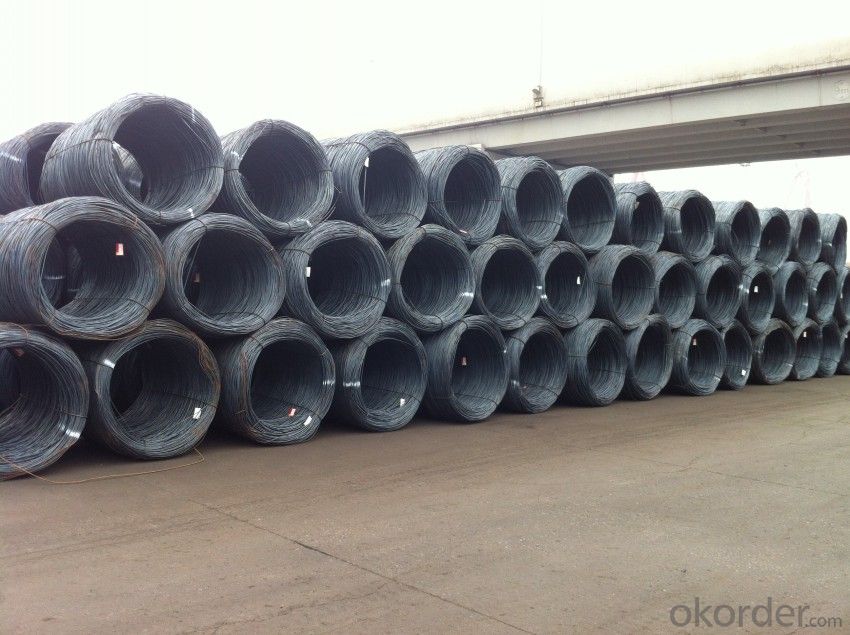
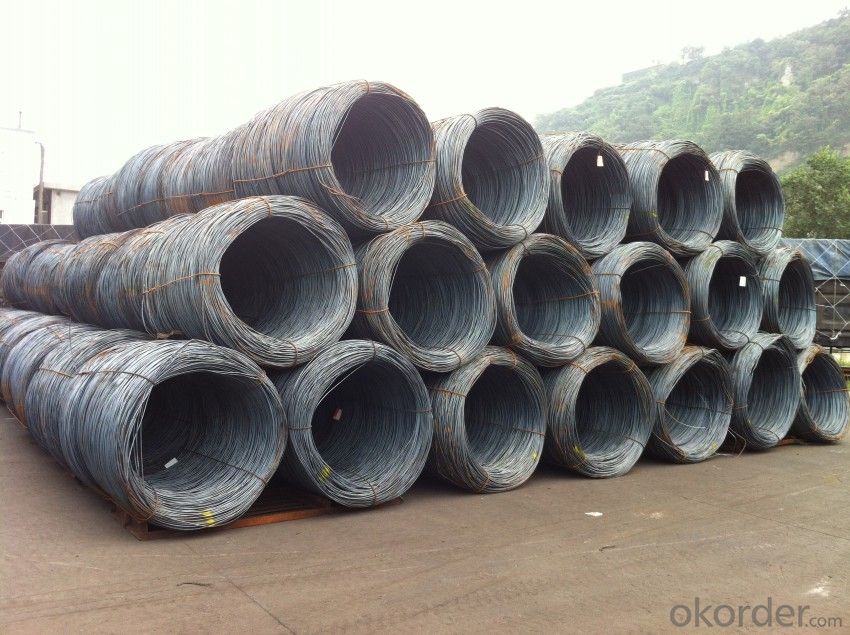
- Q: What are the main factors affecting the electrical conductivity of steel wire rod?
- The main factors affecting the electrical conductivity of steel wire rod are the composition and purity of the steel, the presence of impurities or alloying elements, and the crystal structure of the metal.
- Q: What is the current global production capacity of steel wire rod?
- The current global production capacity of steel wire rod is approximately X million metric tons per year.
- Q: How is steel wire rod used in the manufacturing of wire for electrical heating cables?
- Steel wire rod is an essential component in the manufacturing process of wire for electrical heating cables. The wire rod serves as the primary raw material that undergoes various treatments and transformations to produce the final electrical heating cable wire. To begin with, the steel wire rod is typically made from low-carbon steel, which possesses excellent electrical conductivity and heat resistance properties. This makes it an ideal material for electrical heating cables, as it can efficiently conduct electricity and withstand the high temperatures generated by the cables. The first step in the manufacturing process involves hot rolling the steel wire rod into a thin strip, which is then cold drawn to achieve the desired wire diameter. This cold drawing process imparts high tensile strength and flexibility to the wire, ensuring it can withstand the stress and strain associated with various applications. Once the wire is formed, it is then subject to a series of heat treatments to enhance its electrical conductivity and heat resistance. This may involve annealing, where the wire is heated and slowly cooled to relieve internal stresses and improve its ductility. Additionally, the wire may be subjected to a process called galvanization, which involves coating the wire with a protective layer of zinc to enhance its corrosion resistance. After the heat treatments, the wire is further processed to achieve the required specifications for electrical heating cables. This may involve additional drawing processes to achieve the desired diameter and surface finish. The wire is then wound onto spools or coils, ready to be used in the manufacturing of electrical heating cables. In the final stage of the manufacturing process, the steel wire is incorporated into the construction of electrical heating cables. This typically involves combining the wire with other materials, such as insulation and protective sheathing, to ensure the safety and functionality of the cables. Overall, steel wire rods play a crucial role in the manufacturing of wire for electrical heating cables. Its excellent electrical conductivity, heat resistance, and strength make it an ideal material for this application. Through various treatments and processes, the steel wire rod is transformed into a high-quality wire that can efficiently conduct electricity and withstand the demanding conditions of electrical heating systems.
- Q: What are the main factors influencing the choice of steel wire rod surface finish?
- When determining the appropriate surface finish for a steel wire rod, several factors come into play, each playing a significant role. The intended use of the wire rod is one of the main factors to consider. Different surface finishes offer varying levels of corrosion resistance, lubricity, and adhesion properties. These properties are crucial in determining whether the wire rod is suitable for a specific application. For instance, in a corrosive environment, a surface finish that provides enhanced resistance to rust and oxidation may be necessary. The desired aesthetic appearance is another factor that influences the choice of surface finish. Industries like automotive or consumer goods may have specific requirements for the visual appeal of the wire rod. In such cases, finishes that offer a smooth, polished, or decorative appearance may be preferred. The mechanical properties required for the wire rod's application also play a role in determining the surface finish. Some finishes, such as bright or polished surfaces, can improve the wire rod's yield strength, ductility, and fatigue resistance. These properties are vital in applications involving high-stress conditions or requiring flexibility and durability. Cost considerations are also important when selecting the surface finish. Some finishes require additional processing steps, like pickling, coating, or electroplating, which can increase the overall cost of the wire rod. Therefore, it is essential to balance the desired surface finish with the cost-effectiveness of the manufacturing process. Lastly, environmental and regulatory factors can influence the choice of surface finish. Certain finishes may contain hazardous substances or require specific disposal methods, impacting the environmental footprint of wire rod production. Compliance with industry standards and regulations is crucial to ensure the safety and sustainability of the finished product. In conclusion, the choice of steel wire rod surface finish is influenced by factors such as intended use, aesthetic requirements, mechanical properties, cost considerations, and environmental considerations. By carefully considering these factors, manufacturers can select the most appropriate surface finish that aligns with the specific requirements of the application and ensures optimal performance and quality of the wire rod.
- Q: What are the requirements for steel wire rod used in cable-stayed bridge wire strands?
- The stringent nature of the requirements for steel wire rod used in cable-stayed bridge wire strands stems from the critical role these components play in ensuring the safety and structural integrity of the bridge. Below are some key requirements for steel wire rod used in cable-stayed bridge wire strands: 1. Composition of Material: The steel wire rod must be crafted from high-quality, high-strength steel with specific chemical composition requirements. This is necessary to guarantee the wire's ability to withstand the loads and stresses it will encounter in the cable-stayed bridge. 2. Tensile Strength: The wire rod must possess a minimum tensile strength that fulfills the design requirements of the cable-stayed bridge. This ensures that it can endure the tension forces exerted on it without deformation or failure. 3. Ductility: The steel wire rod must possess adequate ductility to allow for bending and shaping without fracturing or losing its strength properties. This is crucial during the fabrication and installation processes of the wire strands. 4. Uniformity and Consistency: The wire rod should exhibit uniform and consistent material properties throughout its length. This is essential to ensure consistent performance and behavior of the wire strands under various loading conditions. 5. Surface Quality: The surface of the wire rod should be smooth and devoid of defects such as cracks, scratches, or other surface irregularities. This is necessary to prevent stress concentration points or potential initiation sites for failure. 6. Dimensional Accuracy: The wire rod should adhere to specific dimensional tolerances to ensure proper fit and compatibility with the cable-stayed bridge design. This includes requirements for diameter, roundness, and straightness. 7. Resistance to Corrosion: The wire rod must possess effective corrosion resistance properties to withstand exposure to environmental conditions, including moisture, humidity, and chemicals. This contributes to the wire strands' long-term durability and safety. 8. Certification and Testing: The steel wire rod used in cable-stayed bridge wire strands must be manufactured by reputable producers and should be accompanied by relevant certifications and test reports. These documents offer assurance that the wire rod meets the specified requirements and has undergone necessary quality control measures. It is important to note that project-specific requirements and design standards may vary, and the above requirements may not cover all aspects. Consulting the applicable design codes and specifications for cable-stayed bridges is crucial to ensure compliance with the project-specific requirements.
- Q: How is steel wire rod used in the production of wire mesh for food processing?
- Wire mesh for food processing relies heavily on steel wire rod as a vital ingredient. Also known as wire cloth or wire fabric, this versatile material finds applications across various industries, including food processing. Its primary functions involve sieving, filtering, and separating solids and liquids during the production and processing of food products. Steel wire rod acts as the raw material for wire mesh manufacturing. It takes the form of lengthy, cylindrical steel pieces coiled together. Selection of the wire rod depends on desired qualities like strength, durability, and resistance to corrosion, which are essential for its application in the food processing sector. To produce wire mesh for food processing, the steel wire rod undergoes a series of manufacturing processes. Initially, the wire rod is drawn through a series of dies, reducing its diameter and achieving the desired wire thickness. This process, known as wire drawing, enhances the wire's ductility and flexibility. Once the wire attains the desired thickness, it is either woven or welded to form wire mesh. Weaving involves interlacing the wires vertically and horizontally, creating a grid-like pattern. This pattern determines the size of the openings in the wire mesh, facilitating specific particle or liquid filtration. In food processing, stainless steel wire rod is typically used to manufacture wire mesh. Stainless steel is favored due to its high resistance to corrosion, ease of cleaning, and hygienic properties. These qualities make it suitable for applications where food safety and cleanliness are of utmost importance. Wire mesh produced from steel wire rod finds numerous applications in the food processing industry. It is commonly employed as sieves or screens in food processing equipment, such as vibrating sifters or centrifugal separators, to separate or classify particles of different sizes. It can also serve as a conveyor belt or conveyor screen, allowing for the smooth transportation of food products through various processing stages. Moreover, wire mesh can function as protective barriers or covers for food processing machinery, preventing contamination and ensuring worker safety. It can also be used as fencing or enclosures for storage areas or production facilities, creating a secure and controlled environment for food processing operations. All in all, steel wire rod plays a pivotal role in wire mesh production for food processing. Its strength, durability, and resistance to corrosion make it an ideal material for manufacturing wire mesh that meets the stringent requirements of the food processing industry.
- Q: What are the main factors influencing the choice of steel wire rod order confirmation process?
- The main factors influencing the choice of steel wire rod order confirmation process include the quantity and quality of the order, customer preferences and requirements, availability of inventory, production capacity, lead time, pricing, payment terms, and contractual agreements.
- Q: How is the steel wire rod industry affected by government policies and regulations?
- The steel wire rod industry is significantly affected by government policies and regulations. Governments play a crucial role in shaping the industry through various measures, including trade policies, environmental regulations, and labor laws. One of the primary ways government policies impact the steel wire rod industry is through trade policies. Governments often impose tariffs or quotas on steel imports to protect domestic producers. These measures can create barriers to entry for foreign competitors and provide a competitive advantage to domestic manufacturers. By implementing such policies, governments aim to safeguard local jobs and ensure the stability of the domestic steel industry. Additionally, governments impose environmental regulations on the steel wire rod industry to minimize its impact on the environment. These regulations often require steel manufacturers to adopt cleaner technologies, reduce emissions, and adhere to environmental standards. These measures can increase production costs for steel wire rod manufacturers as they invest in pollution control equipment and comply with stricter regulations. However, these regulations are essential for promoting sustainable and responsible manufacturing practices. Labor laws and regulations also have a significant impact on the steel wire rod industry. Governments enforce laws related to minimum wages, working conditions, and worker safety. These regulations are designed to protect the rights and well-being of employees in the industry. Compliance with labor laws can increase labor costs for steel wire rod manufacturers, but it ensures fair treatment and safe working conditions for workers. Furthermore, government policies related to infrastructure development and investment in the construction sector can directly influence the demand for steel wire rods. Government initiatives, such as building new roads, bridges, and other infrastructure projects, create a demand for steel wire rods. The industry benefits from government spending on public construction projects, which stimulates demand and drives growth. In summary, the steel wire rod industry is significantly impacted by government policies and regulations. Trade policies, environmental regulations, labor laws, and infrastructure investments all shape the industry's operations and prospects. Steel wire rod manufacturers must carefully navigate these policies and adapt to changes to remain competitive and compliant.
- Q: What are the different surface finishes available for processed steel wire rod?
- Some of the different surface finishes available for processed steel wire rod include black oxide, galvanized, polished, and coated finishes.
- Q: How is steel wire rod used in the production of wire for springs in furniture?
- Steel wire rod is a crucial raw material used in the production of wire for springs in furniture. The wire rod is typically made from high-quality steel, which is specifically chosen for its excellent strength and durability. To manufacture wire for springs, the steel wire rod goes through a series of manufacturing processes. Initially, the wire rod is heated and then passed through a series of dies to gradually reduce its diameter. This process is called drawing, and it helps to improve the wire's tensile strength, flexibility, and surface finish. After the wire has been drawn to the desired thickness, it is coiled onto spools and sent to the spring production facility. At the facility, the wire is further processed to create different types of springs used in furniture. For furniture springs, the wire is typically coiled into helical shapes. This coiling process can be done manually or by using specialized machines, depending on the scale of production. The wire's high tensile strength ensures that the springs can withstand the weight and pressure exerted on them when someone sits or lies on the furniture. Once the springs are formed, they are then attached to the furniture frame using various techniques such as tying, stapling, or welding. These springs play a crucial role in providing support and comfort to the furniture, ensuring that users have a comfortable seating or sleeping experience. In conclusion, steel wire rod is essential in the production of wire for springs in furniture. Its excellent strength and durability make it an ideal material for creating high-quality springs that can withstand the demands placed on them. The resulting springs provide the necessary support and comfort for furniture, enhancing the overall user experience.
Send your message to us
Hot Rolled Wire Rods with Good Price SAE 1008
- Loading Port:
- Tianjin
- Payment Terms:
- TT OR LC
- Min Order Qty:
- 25 m.t.
- Supply Capability:
- 10000 m.t./month
OKorder Service Pledge
OKorder Financial Service
Similar products
Hot products
Hot Searches
Related keywords
